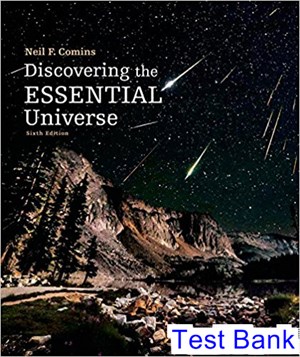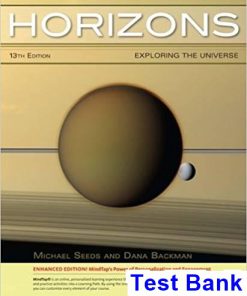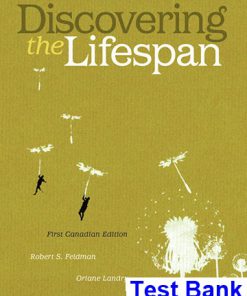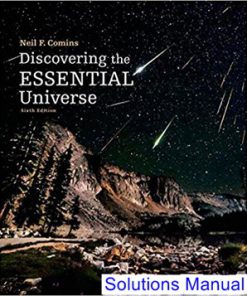Discovering the Essential Universe 6th Edition Comins Test Bank
$26.50$50.00 (-47%)
Discovering the Essential Universe 6th Edition Comins Test Bank.
You may also like
This is completed downloadable of Discovering the Essential Universe 6th Edition Comins Test Bank

Product Details:
- ISBN-10 : 1464181705
- ISBN-13 : 978-1464181702
- Author:
Neil Comins’ Discovering the Universe confronts the challenges of the one-term astronomy course by heightening student curiosities about the cosmos, by using the context of astronomy to teach the process of science, and by highlighting common misconceptions and showing students how to think their way past them. With its signature combination of vivid writing and spectacular images, the new edition offers new findings, new study help, and an expanded new media/supplements package centered on W.H. Freeman’s breakthrough online course space, LaunchPad.
Table of Content:
- CHAPTER 1 Discovering the Night Sky
- NAVIGATING THE NIGHT SKY
- 1-1 The night sky is full of patterns
- 1-2 Constellations make locating stars easy
- 1-3 The celestial sphere aids in navigating the sky
- 1-4 An “alt”ernative coordinate system
- 1-5 Earth orbits the Sun in a plane called the ecliptic
- EARTHLY CYCLES
- 1-6 Earth’s rotation creates the day-night cycle and its revolution defines a year
- THE SEASONS
- 1-7 The seasons result from the tilt of Earth’s rotation axis combined with Earth’s revolution aroun
- 1-8 Clocks and calendars are based on Earth’s rotation and revolution
- 1-9 Precession is a slow, circular motion of Earth’s axis of rotation
- THE PHASES OF THE MOON
- 1-10 The phases of the Moon originally inspired the concept of the month
- ECLIPSES
- 1-11 Eclipses do not occur during every new or full Moon phase
- 1-12 Three types of lunar eclipses occur
- 1-13 Three types of solar eclipses also occur
- SCALES OF THE UNIVERSE
- 1-14 Astronomical distances are, well, astronomical
- Summary of Key Ideas
- CHAPTER 2 Gravitation and the Motion of the Planets
- SCIENCE: KEY TO COMPREHENDING THE COSMOS
- 2-1 Science is both a body of knowledge and a process of learning about nature
- CHANGING OUR EARTH-CENTERED VIEW OF THE UNIVERSE
- 2-2 The belief in a Sun-centered cosmology formed slowly
- DISCOVERY 2-1 Earth-Centered Universe
- 2-3 Copernicus devised the first comprehensive heliocentric cosmology
- 2-4 Tycho Brahe made astronomical observations that disproved ancient ideas about the heavens
- KEPLER’S AND NEWTON’S LAWS
- 2-5 Kepler’s laws describe orbital shapes, changing speeds, and the lengths of planetary years
- DISCOVERY 2-2 Units of Astronomical Distance
- 2-6 Galileo’s discoveries strongly supported a heliocentric cosmology
- 2-7 Newton formulated three laws that describe fundamental properties of physical reality
- 2-8 Newton’s description of gravity accounts for Kepler’s laws
- Summary of Key Ideas
- CHAPTER 3 Light and Telescopes
- THE NATURE OF LIGHT
- 3-1 Newton discovered that white is not a fundamental color and proposed that light is composed of p
- 3-2 Light travels at a finite but incredibly fast speed
- 3-3 Einstein showed that light sometimes behaves as particles that carry energy
- 3-4 Visible light is only one type of electromagnetic radiation
- OPTICS AND TELESCOPES
- 3-5 Reflecting telescopes use mirrors to concentrate incoming starlight
- 3-6 Telescopes brighten, resolve, and magnify
- 3-7 Eyepieces, refracting telescopes, and binoculars use lenses to focus incoming light
- 3-8 Shaping telescope mirrors and lenses is an evolving science
- 3-9 Storing and analyzing light from space is key to understanding the cosmos
- 3-10 Earth’s atmosphere hinders astronomical research
- CAPTURING NONVISIBLE LIGHT: NONOPTICAL ASTRONOMY
- 3-11 Specially designed telescopes gather electromagnetic energy in all of the nonvisible parts of t
- BLACKBODY RADIATION
- 3-12 An object’s peak color shifts to shorter wavelengths as it is heated
- 3-13 The relative intensities of different emitted colors reveal a star’s surface temperature
- IDENTIFYING THE ELEMENTS BY ANALYZING THEIR UNIQUE SPECTRA
- 3-14 Each chemical element produces its own unique set of spectral lines
- 3-15 The various brightness levels of spectral lines depend on conditions in the spectrum’s source
- ATOMS AND SPECTRA
- 3-16 An atom consists of a small, dense nucleus surrounded by electrons
- 3-17 Spectra occur because electrons absorb and emit photons with only certain wavelengths
- 3-18 Spectra provide information about motion of objects toward or away from us but not across the s
- Summary of Key Ideas
- CHAPTER 4 Formation of the Solar System
- THE SOLAR SYSTEM CONTAINS HEAVY ELEMENTS, FORMED FROM AN EARLIER GENERATION OF STARS
- 4-1 Stars transform matter from lighter elements into heavier ones
- 4-2 Gravity, rotation, collisions, and heat shaped the young solar system
- THE FORMATION OF THE PLANETS
- 4-3 The giant planets formed in sequence
- 4-4 The inner planets formed primarily from collisions
- DEBRIS: REMNANTS IN THE SOLAR SYSTEM
- 4-5 The changing orbits of the giant planets spread debris throughout the solar system
- 4-6 The asteroid belt is leftover debris
- 4-7 The infalling debris from the giant planets led to the Late Heavy Bombardment
- CATEGORIES OF THE PRESENT-DAY SOLAR SYSTEM
- 4-8 The categories of solar system objects have evolved
- 4-9 The orbits of the planets are related
- 4-10 The Sun developed while the planets matured
- Summary of Key Ideas
- CHAPTER 5 Exoplanets
- EXOPLANETS—PLANETS OUTSIDE OUR SOLAR SYSTEM
- 5-1 Protoplanetary disks are a common part of the star-forming process
- 5-2 Astronomers have at least seven different ways of detecting planets outside our solar system
- 5-3 Exoplanets orbit a breathtaking variety of stars
- 5-4 Exoplanets with a wide range of sizes, masses, and compositions have been observed
- 5-5 Stars with multiple planets have been observed
- 5-6 Many exoplanets have extraordinary orbits, as compared to those in our solar system
- 5-7 Planets that are not orbiting stars have also been observed
- 5-8 There are billions and billions of planets
- 5-9 Planets with liquid water are being discovered
- 5-10 The search for life on exoplanets is under way
- Summary of Key Ideas
- CHAPTER 6 The Terrestrial Planets and Their Moons
- COMPARATIVE PLANETOLOGY
- 6-1 Comparisons of the eight planets show distinct similarities and significant differences
- EARTH: A DYNAMIC, VITAL WORLD
- 6-2 Earth’s atmosphere has evolved over billions of years
- 6-3 Plate tectonics produce major changes on Earth’s surface
- 6-4 Earth’s interior consists of a rocky mantle and an iron-rich core
- 6-5 Earth’s magnetic field shields us from the solar wind
- THE MOON AND TIDES
- 6-6 The Moon’s surface is covered with craters, plains, and mountains
- 6-7 Visits to the Moon yielded invaluable information about its history
- 6-8 The Moon probably formed from debris cast into space when a huge planetesimal struck the young E
- 6-9 Tides have played several important roles in the history of Earth and the Moon
- 6-10 The Moon is moving away from Earth
- MERCURY
- 6-11 Photographs from Mariner 10 and Messenger spacecraft reveal Mercury’s lunarlike surface
- 6-12 Mercury has a higher percentage of iron than Earth
- 6-13 Mercury’s rotation and revolution are coupled
- 6-14 Mercury’s atmosphere is the thinnest of all terrestrial planets
- VENUS
- 6-15 The surface of Venus is completely hidden beneath a permanent cloud cover
- 6-16 The greenhouse effect heats Venus’s surface
- 6-17 Venus is covered with gently rolling hills, two “continents,” and numerous volcanoes
- MARS
- 6-18 Mars’s global features include plains, canyons, craters, and volcanoes
- 6-19 Although no canals exist on Mars, it does have some curious natural features
- 6-20 Mars’s interior is less molten than the inside of Earth
- 6-21 Martian air is thin and often filled with dust
- 6-22 Surface and underground features indicate that water once flowed on Mars
- 6-23 Search for microscopic life on Mars continues
- 6-24 Mars’s two moons look more like potatoes than spheres
- COMPARATIVE PLANETOLOGY OF THE INNER PLANETS
- 6-25 Comparisons of planetary features provide new insights
- Summary of Key Ideas
- CHAPTER 7 The Outer Planets and Their Moons
- JUPITER
- 7-1 Jupiter’s outer layer is a dynamic area of storms and turbulent gases
- 7-2 Jupiter’s interior has four distinct regions
- 7-3 Impacts provide probes into Jupiter’s atmosphere
- JUPITER’S MOONS AND RINGS
- 7-4 Io’s surface is sculpted by volcanic activity
- 7-5 Europa harbors liquid water below its surface
- 7-6 Ganymede is larger than Mercury
- 7-7 Callisto bears the scars of a huge asteroid impact
- 7-8 Other debris orbits Jupiter as smaller moons and ringlets
- SATURN
- 7-9 Saturn’s atmosphere, surface, and interior are similar to Jupiter
- 7-10 Saturn’s spectacular rings are composed of fragments of ice and ice-coated rock
- 7-11 Titan has a thick atmosphere, clouds, and lakes filled with liquids
- 7-12 Rhea has ice
- 7-13 Enceladus has water jets, an atmosphere, and a magnetic field
- URANUS
- 7-14 Uranus sports a hazy atmosphere and clouds
- 7-15 A system of rings and satellites revolves around Uranus
- NEPTUNE
- 7-16 Neptune was discovered because it had to be there
- 7-17 Neptune has rings and captured moons
- COMPARATIVE PLANETOLOGY OF THE OUTER PLANETS
- Summary of Key Ideas
- CHAPTER 8 Vagabonds of the Solar System
- DWARF PLANETS
- 8-1 Pluto and its moon, Charon, are about the same size
- 8-2 Ceres is a dwarf planet in the asteroid belt, while Pluto, Eris, Haumea, and Makemake are trans-
- SMALL SOLAR SYSTEM BODIES
- ASTEROIDS
- 8-3 Most asteroids orbit the Sun between Mars and Jupiter
- 8-4 Jupiter’s gravity creates gaps in the asteroid belt
- 8-5 Asteroids also orbit outside the asteroid belt
- COMETS
- 8-6 Comets come from far out in the solar system
- 8-7 Comet tails develop from gases and dust pushed outward by the Sun
- 8-8 Comets are fragile yet durable
- 8-9 Comets do not last forever
- METEOROIDS, METEORS, AND METEORITES
- 8-10 Small, rocky debris peppers the solar system
- 8-11 Meteorites are space debris that land intact
- 8-12 The Allende meteorite provides evidence of catastrophic explosions
- 8-13 Asteroid impacts with Earth have caused mass extinctions
- Summary of Key Ideas
- CHAPTER 9 The Sun: Our Extraordinary Ordinary Star
- THE SUN’S ATMOSPHERE
- 9-1 The photosphere is the visible layer of the Sun
- 9-2 The chromosphere is characterized by spikes of gas called spicules
- 9-3 The outermost layer of the Sun’s atmosphere, the corona, is exceptionally hot
- THE ACTIVE SUN
- 9-4 Sunspots reveal the solar cycle and the Sun’s rotation
- 9-5 The Sun’s magnetic fields create sunspots
- 9-6 Solar magnetic fields also create other atmospheric phenomena
- THE SUN’S INTERIOR
- 9-7 Thermonuclear reactions in the core of the Sun produce its energy
- 9-8 The solar model describes how energy escapes from the Sun’s core
- DISCOVERY 9-1 T hermonuclear Fusion
- 9-9 The Sun has gotten brighter over time
- 9-10 The mystery of the missing neutrinos inspired research into the fundamental nature of matter
- Summary of Key Ideas
- CHAPTER 10 Characterizing Stars
- LEAVING THE SOLAR SYSTEM
- 10-1 Distances to nearby stars are found using stellar parallax
- DISCOVERY 10-1 Distances to Nearby Stars
- MAGNITUDE SCALES
- 10-2 Apparent magnitude measures the brightness of stars as seen from Earth
- 10-3 Absolute magnitudes and luminosities do not depend on distance
- DISCOVERY 10-2 T he Distance–Magnitude Relationship
- THE TEMPERATURES OF STARS
- 10-4 A star’s color reveals its surface temperature
- 10-5 A star’s spectrum also reveals its surface temperature
- 10-6 Stars are classified by their spectra
- TYPES OF STARS
- 10-7 The Hertzsprung-Russell diagram identifies distinct groups of stars
- 10-8 Luminosity classes set the stage for understanding stellar evolution
- 10-9 A star’s spectral type and luminosity class provide a second distance-measuring technique
- DISCOVERY 10-3 Kepler’s Third Law and Stellar Masses
- STELLAR MASSES
- 10-10 Binary stars provide information about stellar masses
- 10-11 Main-sequence stars have a relationship between mass and luminosity
- 10-12 The orbital motion of binary stars affects the wavelengths of their spectral lines
- Summary of Key Ideas
- CHAPTER 11 The Lives of Stars from Birth Through Middle Age
- PROTOSTARS AND PRE–MAIN-SEQUENCE STARS
- 11-1 Gas and dust exist between the stars
- 11-2 Supernovae, collisions of interstellar clouds, and starlight trigger new star formation
- 11-3 When a protostar ceases to accumulate mass, it becomes a pre–main-sequence star
- 11-4 The evolutionary track of a pre–main-sequence star depends on its mass
- 11-5 H II regions harbor young star clusters
- 11-6 Plotting a star cluster on an H-R diagram reveals its age
- MAIN-SEQUENCE AND GIANT STARS
- 11-7 Stars spend most of their lives on the main sequence
- EVOLUTION OF LOW MASS (0.08–0.4 M(Omitted)) STARS
- 11-8 Red dwarfs convert essentially their entire mass into helium
- EARLY AND MIDDLE EVOLUTION OF INTERMEDIATE (0.4–8 M(Omitted)) AND HIGH-MASS STARS
- 11-9 When core hydrogen fusion slows down, a main-sequence star with mass greater than 0.4 M(Omitted
- 11-10 Helium fusion begins at the center of a giant
- 11-11 Life in the giant phase has its ups and downs
- VARIABLE STARS
- 11-12 A Cepheid pulsates because it is alternately expanding and contracting
- 11-13 Cepheids enable astronomers to estimate vast distances
- 11-14 Globular clusters are bound groups of old stars
- 11-15 Mass transfer in close binary systems can produce unusual double stars
- Summary of Key Ideas
- CHAPTER 12 The Deaths and Remnants of Stars
- INTERMEDIATE-MASS (0.4 M(Omitted)–8 M(Omitted)) STARS AND PLANETARY NEBULAE
- 12-1 Intermediate-mass stars become supergiants before expanding into planetary nebulae
- 12-2 The burned-out core of an intermediate-mass star becomes a white dwarf
- HIGH-MASS STARS (GREATER THAN 8 M(Omitted)) AND TYPE II SUPERNOVAE
- 12-3 A series of fusion reactions in high-mass stars leads to luminous supergiants
- 12-4 High-mass stars blow apart in Type II supernova explosions
- 12-5 Supernova remnants are observed in many places
- NEUTRON STARS AND PULSARS
- 12-6 The cores of many Type II supernovae become neutron stars
- 12-7 A rotating magnetic field explains the pulses from a neutron star
- 12-8 Neutron stars have internal structure
- 12-9 Colliding neutron stars may provide some of the heavy elements in the universe
- 12-10 Binary neutron stars create pulsating X-ray sources
- THE RELATIVITY THEORIES
- 12-11 Einstein revolutionized our understanding of space, time, and gravity
- INSIDE A BLACK HOLE
- 12-12 Matter in a black hole becomes much simpler than elsewhere in the universe
- 12-13 Falling into a black hole is an infinite voyage
- EVIDENCE FOR BLACK HOLES
- 12-14 Several binary star systems contain black holes
- 12-15 Other black holes range in mass up to billions of solar masses
- 12-16 Black holes and neutron stars in binary systems often create jets of gas
- GAMMA-RAY BURSTS
- 12-17 Gamma-ray bursts are the most powerful explosions in the known universe
- 12-18 Black holes evaporate
- Summary of Key Ideas
- CHAPTER 13 The Galaxies
- THE MILKY WAY
- 13-1 Studies of Cepheid variable stars revealed that the Milky Way is only one of many galaxies
- 13-2 Cepheid variables help us locate our Galaxy’s center
- 13-3 Nonvisible observations help map the galactic disk
- 13-4 The galactic nucleus is an active, crowded place
- 13-5 Our Galaxy’s disk is surrounded by a two-shell spherical halo of stars and other matter
- 13-6 The Galaxy is rotating
- MYSTERIES AT THE GALACTIC FRINGES
- 13-7 Most of the matter in the Galaxy has not yet been identified
- TYPES OF GALAXIES
- 13-8 The winding of a spiral galaxy’s arms is correlated to the size of its central bulge
- 13-9 Explosions create flocculent spirals, and waves create grand-design spirals
- 13-10 Bars of stars run through the central bulges of barred spiral galaxies, and some disk galaxies
- 13-11 Elliptical galaxies display a wide variety of sizes and masses
- 13-12 Galaxies without global structure are called irregular
- 13-13 Hubble presented spiral and elliptical galaxies in a tuning fork–shaped diagram
- CLUSTERS AND SUPERCLUSTERS
- 13-14 Galaxies exist in clusters that may form still larger clumps called superclusters
- 13-15 Galaxies in a cluster can collide and combine
- 13-16 Dark matter helps hold together individual galaxies and clusters of galaxies
- SUPERCLUSTERS IN MOTION
- 13-17 The redshifts of superclusters indicate that the universe is indeed expanding
- DISCOVERY 13-1 The Tully–Fisher Relation and Other Distance-Measuring Techniques
- DISCOVERY 13-2 The Expanding Universe
- 13-18 Astronomers are looking back to a time when galaxies were first forming
- QUASARS
- 13-19 Quasars look like stars but have huge redshifts
- OTHER ACTIVE GALAXIES
- 13-20 Active galaxies can be either spiral or elliptical
- SUPERMASSIVE ENGINES
- 13-21 Supermassive black holes exist at the centers of most galaxies
- 13-22 Jets of protons and electrons ejected from around black holes help explain active galaxies
- 13-23 Gravity focuses light from quasars
- Summary of Key Ideas
- CHAPTER 14 Cosmology
- COSMOLOGY
- 14-1 General relativity predicts an expanding (or contracting) universe
- 14-2 The expansion of the universe creates a Dopplerlike redshift
- 14-3 The Hubble constant is related to the age of the universe
- THE BIG BANG
- 14-4 Remnants of the Big Bang have been detected
- 14-5 The universe has two symmetries—isotropy and homogeneity
- A BRIEF HISTORY OF SPACETIME, MATTER, ENERGY, AND EVERYTHING
- 14-6 All physical forces in nature were initially unified
- 14-7 Equations explain the evolution of the universe, even before matter and energy, as we know them
- 14-8 Homogeneity and isotropy are results of inflation
- 14-9 During the first second, most of the matter and antimatter in the universe annihilated each oth
- 14-10 The universe changed from being controlled by radiation to being controlled by matter
- THE STRUCTURE OF THE UNIVERSE
- 14-11 Galaxies formed from huge clouds of primordial gas
- 14-12 Star formation activity determines a galaxy’s initial structure
- THE FATE OF THE UNIVERSE
- 14-13 The average density of matter is one factor that determines the future of the universe
- 14-14 The overall shape of spacetime affects the future of the universe
- 14-15 Dark energy is causing the universe to accelerate outward
- Summary of Key Ideas
- DISCOVERY 14-1 Superstring Theory and M-Theory
- CHAPTER 15 Astrobiology
- 15-1 Astrobiology connects the cosmos and the origins of life
- 15-2 The existence of life depends on chemical and physical properties of matter
- 15-3 Evidence is mounting that life might exist elsewhere in our solar system
- 15-4 Searches for advanced civilizations try to detect their radio signals
- 15-5 The Drake equation: How many civilizations are likely to exist in the Milky Way?
- 15-6 Humans have been sending signals into space for more than a century
- Summary of Key Ideas
- Appendices
- A: Powers-of-Ten Notation
- B: Temperature Scales
- C The Planets: Orbital Data
- D: The Planets: Physical Data
- E: Major Satellites of the Planets by Mass
- F: The Nearest Stars
- G: The Visually Brightest Stars
- H: The Constellations
- I: Some Useful Astronomical Quantities
- J: Some Useful Physical Constants
- K: Common Conversions between U.S. Customary and Metric Units
- L: Mass and Energy Inventory for the Universe
- M: Reading Graphs
- N: Periodic Table of the Elements
- O: Tides
- P: Energy and Momentum
- Q: Radioactivity and the Ages of Objects
- R: Gravitational Force
- S: Largest Optical Telescopes in the World
- Glossary
- A
- B
- C
- D
- E
- F
- G
- H
- I
- J
- K
- L
- M
- N
- O
- P
- Q
- R
- S
- T
- U
- V
- W
- X
- Z
- Answers to Computational Questions
- Index
- A
- B
- C
- D
- E
- F
- G
- H
- I
- J
- K
- L
- M
- N
- O
- P
- Q
- R
- S
- T
- U
- V
- W
- X
- Y
- Z
- EULA
People Also Search:
discovering the essential universe comins
discovering the essential universe 6th edition comins
discovering the essential universe
discovering the essential universe 6th edition
discovering the essential universe 6th edition download scribd
discovering the essential universe 6th edition testbank download pdf












